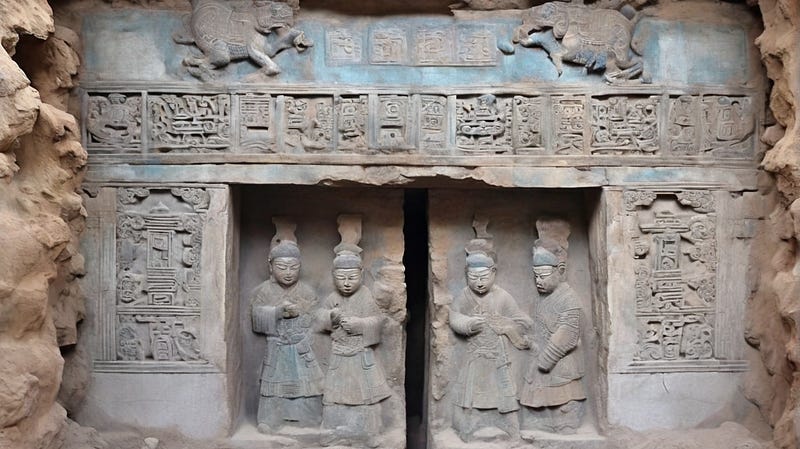The Remarkable Unveiling of a Ming Dynasty Tomb in China
Written on
Chapter 1: The Discovery of the Tomb
In the city of Xinzhou, situated in Shanxi province, archaeologists have made an incredible find while preparing for the construction of a new national highway. A team from the local Institute of Cultural Relics and Archaeology was assigned to conduct routine surveys before the work commenced. To their amazement, they discovered a door that led to an ancient tomb, initiating months of research that unveiled a series of astonishing artifacts.

Section 1.1: Insights into the Ming Dynasty
Researchers have dated the tomb back to the Ming dynasty, a significant period in Chinese history that lasted from 1368 to 1644. Zhu Yuanzhang, a prominent leader during the rebellion against the Yuan dynasty, established this imperial family. After his victory, he proclaimed himself emperor, initiating the Hongwu era and naming the dynasty "Ming," which translates to "Splendid."
Notably, the Forbidden City was constructed in Beijing in 1420 during this time, serving as the emperor's residence. The monumental project employed nearly a million laborers and took 15 years to complete. Under Emperor Yongle, major advancements were made, including the reconstruction of the Grand Canal and flourishing trade relations with Europe and Japan, facilitating the exchange of silk, porcelain, and silver. The Ming dynasty was also marked by significant achievements in the arts, including painting, poetry, music, and literature.
This documentary explores the remarkable discoveries made within the tomb, showcasing the intricate artifacts and the historical context surrounding the Ming dynasty.
Section 1.2: Remarkable Preservation of Artifacts
Experts estimate that this tomb is at least 430 years old, but the state of preservation astonished the researchers.
"Even after all these years, we uncovered stunning funerary artifacts, including two well-preserved wooden coffins," noted the archaeologists. "In Shanxi, it is quite rare to encounter a tomb that retains such excellent condition and intact wooden furnishings."
The structure comprises a low corridor spanning 17 meters, a central burial chamber, and a smaller rear chamber, totaling approximately 25.3 meters. The sealed doors were elegantly designed, featuring a stone facade that mimicked wood, adorned with dragon head carvings and floral motifs.
The preserved wooden coffins displayed intricate designs, including painted peacocks and flower embellishments, while the second coffin was highlighted by golden diamond patterns. Within the smaller chamber, researchers found wooden altars, tables, chairs, figurines, as well as tin vessels and personal items like inkwells and brushes.
Chapter 2: A Noble's Final Resting Place
The second video delves into the tomb of the first emperor of China, revealing insights into ancient burial practices and the significant findings from this historic site.
Section 2.1: Epitaphs of Nobility
Inscriptions on the coffins indicate that a nobleman was interred here. One inscription was decoded as "Epitaph of Ming Prince Ru Hou’an," suggesting that a person of noble descent lay within. The second coffin featured the inscription "Ming Gu Rong Kao Hou Ru Wang Gong," interpreted as "Entrusted by the Ming dynasty to serve the royal court as a palace official."
Given the nature of the burial artifacts, it’s plausible that the nobleman had pursuits in painting or writing, as affluent members of the royal family often engaged in various forms of artistic expression.
Section 2.2: A Wealth of Historical Context
Excavations associated with the highway project also uncovered remnants from the Longshan period (2900–2100 BCE) and the Warring States period (475–221 BCE), along with over 60 other tombs from the Han, Tang, Jin, Yuan, and Qing dynasties.
Are Microplastics Deadlier Than We Imagined?
A recent groundbreaking study conducted by Italian scientists has revealed that microplastics can accumulate in human arteries, raising serious health concerns...
Dear Readers
I would like to bring attention to a challenge faced by content creators like myself on Medium.com. Despite dedicating substantial effort to crafting meaningful content, the financial rewards are often minimal. If you appreciate my articles, please consider supporting my work through my “Buy Me a Coffee” page. Your contributions, no matter how small, inspire me to continue producing engaging and thought-provoking content. Thank you for being part of this journey!

